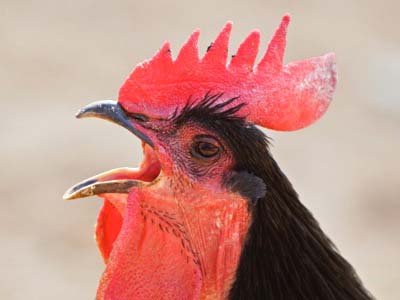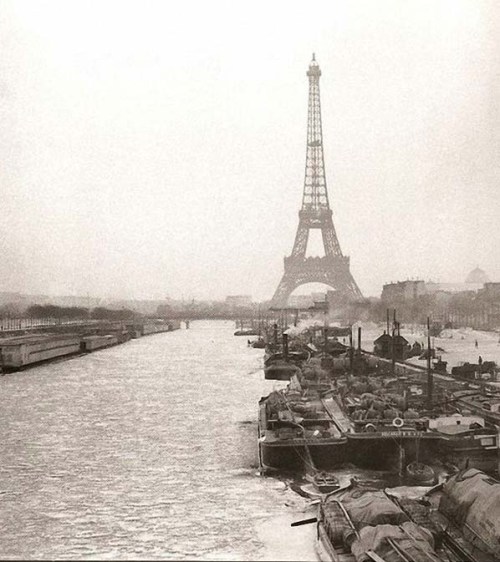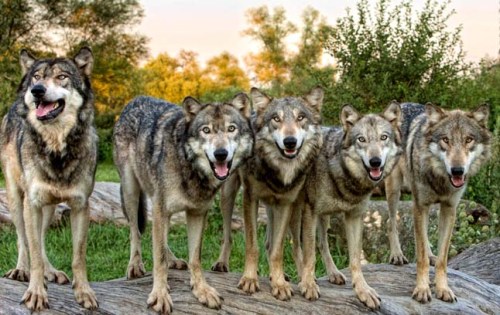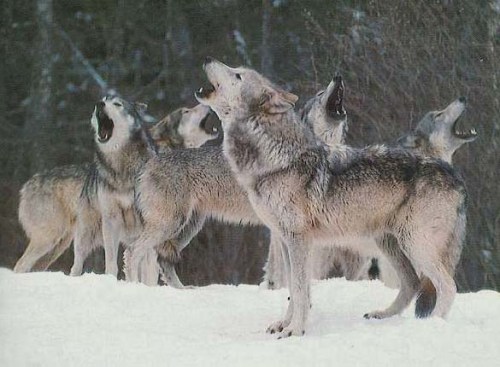I have always thought that France was fairly unlucky as a country to have been ravaged over the centuries by various Beasts, the majority of which nobody has been able to identify with 100% certainty. They have all been dismissed as merely oversized wolves, perhaps with attitude problems, but, somehow, I just cannot agree with that. Too many people who saw wolves perhaps three or four times a week were completely puzzled when they saw the Beast of Gévaudan, for example:
Or when they saw the Beast of Benais or the Beast of Sarlat or the Beast of Auxerrois/ Trucy or the others whose individual blogposts I have not yet launched out into “Le Monde du Blogging”. Creatures such as the Beast of Lyonnais or the Beast of Cévennes/Gard/Vivarais or the Beast of Caen and Chaigny or the Beast of Orléans or the Beast of Veyreau. The Beast of Cinglais or the Beast of Gâtinais. The blood splattered list goes on.
What I did not realise, though, is that there are completely documented and wholly accepted historical accounts which detail attacks on Paris by wolves. And not just one wolf or even one pack of wolves. These were a whole series of large scale attacks by animals which broke all of our present day rules of how to be a politically correct wolf. They gleefully attacked and ate people. French people. Parisians:
The first wolf invasion came during the winter of 1419-1420. Over Europe as a whole, the weather that winter was unbelievably cold. In the east, in what is now Turkey, the Bosphorus was completely frozen over and it was possible to walk over the ice from Üsküdar to Istanbul, which was then called Constantinople.
In Western Europe, virtually all of France had already been made wretched by the debilitating effects of the Hundred Years War which was to last, rather inaccurately, 116 years, from 1337–1453:
The winter of 1419-1420 was equally severe over the whole country with very low temperatures and copious amounts of snow falling for prolonged periods. Paris was occupied by the English and the famine there was so great that unfortunate Parisians spent all of their daylight hours wandering around just searching for food. Numerous packs of wolves, as hungry as the people, advanced into the suburbs of the capital, which was now just a vast, frozen wasteland. The River Seine froze over and people could cross over from one side to the other without problem:
Two years later, in 1421-1422, there was another winter of almost unbelievable severity. Wolves again entered the city. Every night they roamed around the streets of Paris, dug up recently buried corpses in the local graveyards and ate them. Anybody who tried to intervene was ripped to pieces and eaten, presumably, as a second course. Any wolves which were killed were strung up in the streets by their back legs the following morning, as a perhaps, slightly over optimistic warning to the rest.
It was so cold during this winter that bottles of wine, grape juice and vinegar froze in the cellars of Parisian houses and in some cases icicles formed on the vaults of cellar roofs. The River Seine, which had previously been in spate, froze over in less than three days and the ice quickly became firm enough to walk on. On January 12th 1422, there began in the French capital what was considered at the time to be the most severe spell of cold ever experienced by man.
The River Seine froze completely throughout its entire length. Wells froze after four days. This harsh cold persisted for almost three weeks. To compound Parisian misery, a couple of days before the beginning of this extremely cold weather, there had been a heavy snowfall. Because of the severity of this snow and the subsequent extreme cold, people were completely unable to work. Instead, they resorted to jumping games, playing ball and other vigorous activities to keep warm. The freezing conditions were so intense that the ice in the streets and public squares persisted until March 25th. It was so cold that on the heads of cockerels and hens, their combs froze:
Equally surprisingly, there were no wolves reported in Paris during the extremely harsh winter of 1433-1434. The big freeze began on December 31st 1433 and then lasted for nine days short of three months. After this, another severely cold period followed, from March 31st 1434 until April 17th 1434. Just as a comparison, during this particular winter, the entire River Thames in England had frozen completely solid from December to February and remained completely impassable to shipping.
The wolves, though, were back with a vengeance in the second Parisian “Winter of the Wolf”, “L’Hiver du Loup”. This came in 1437–1438, when the weather was equally, if not more, glacial.
The River Seine again froze over completely and packs of wolves wandered into the French capital, roaming the streets in search of food. Here is an anachronistic photo of the River Seine, frozen over in 1437. How can you tell that, mon cher Sherlock?
In actual fact, there had been five unbelievably cold winters in succession over the whole of the European continent, and this was the last of the five. In England, the famine was so severe from 1437-39 that it was second only to the worst years ever in 1315-1317. These latter years were so wet that virtually all the nation’s crops failed and as many as 10% of the population may have eventually perished, in a decade characterised by crime, disease, mass death and cannibalism.
From 1437-1439, though, the winter cold was such that the English people in the countryside were driven to attempt to make bread from fern roots and ivy berries. An unbelievably prudent Mayor of London had avoided this situation in the capital by importing a good supply of rye from Prussia. This may have been Mayor William Estfeld (1437) or Mayor Robert Large (1439) but personally I would go for Stephen Broun the Grocer (1438).
The only record of wolves in Paris which I have been able to trace during these three years of 1437-1439 came as early as the last week of the month of September 1439, when a desperate pack entered the city in search of fresh meat. They ripped out the throats of around fourteen people and duly devoured them. This occurred in the area between Montmartre in the north of the city:
And the Porte Saint-Antoine in the east, right next to the Bastille prison:
From 1450-1850, and possibly beyond that, into the early years of the twentieth century, the so-called Little Ice Age held sway over Europe. In 1457-1458 in Germany, for example, extreme cold froze the Danube River to such a thickness that an army of 40,000 men was able to camp on the ice. Two years, later during the winter of 1459-1460, the entire Baltic Sea was frozen and people could cross between Denmark, Germany and Sweden both on foot and on horseback:
In France, the most severe weather came right at the beginning of the Little Ice Age during their very worst winter of 1449-1450. During this period the weather in France was very wet, extremely cold, and there were, consequently, huge quantities of snow. Indeed, the winter had begun as early as October 1449, when large numbers of olive trees began to die of the cold across the whole country.
It was during this exceptional winter that Paris became the victim of its most famous attack by man-eating wolves, “des loups anthropophages” (a very useful mouthful, should you ever need the phrase on holiday, or perhaps wish to prove your sobriety to a French police officer).
This pack, “The Wolves of Paris”, (Oh somebody, form a Heavy Metal Band…the name is crying out for it!), “Les Loups de Paris”, are thought to have killed and eaten large numbers of hapless human victims of all ages over the course of the winter. The animals initially entered Paris through the very large holes in its dilapidated city walls, which had been built some 250 years previously in the early 13th century. Of course, the original builder, King Philippe Auguste, had intended the walls to protect the city from human invaders rather than animal predators:
The leader of the pack was a wolf named “Courtaud” which means “Bobtail”, as he had a tail which had been “docked” or shortened in some unknown incident. The descriptions of “Courtaud” at the time said that he was reddish in colour, not really a pigment that you would expect in a pure 100% common, Eurasian or Middle Russian forest wolf as the subspecies canis lupus lupus is variously known across Europe. Suggestions have been made that its unusual colour was because it was an Iberian Wolf canis lupus signatus on its holidays from Spain, but there is a problem with that. As far as I can see, the Iberian Wolf is not particularly reddish. Here he is. Just look at that blood:
According to the Wikipedia entry in the link above, canis lupus signatus has a lighter build than the European Wolf, some white marks on the upper lips, dark marks on the tail and a pair of dark marks in its front legs. There is no mention of red.
Don’t get me started, but my explanation for all those various Beasts (bêtes féroces, bêtes dévorantes ou bêtes anthropophages) which ravaged France over the centuries now comes into its own. I believe that they were members of a more aggressive, larger and now extinct species of wolf. If any unusual colour is mentioned for La Bête du Gévaudan, La Bête de Cinglais, La Bête de Caen, La Bête du Lyonnais or La Bête du Vivarais, it is always, exclusively, red. And, as we have just seen, Courtaud too had fur of this colour.
That is why I just do not believe that ordinary wolves were responsible for these blood spattered killings. And anyway, aren’t ordinary wolves a friendly looking bunch of chaps? They would not dream of eating anybody:
At first, there were around twenty wolves in the Parisian pack and they killed dozens of people. Gradually, wolf numbers built up, and the list of victims grew longer and longer. In the first month, supposedly around forty people perished, with a total kill for the whole winter of several hundred. They included, for the most part, anybody the wolves found wandering around the city at night, or any individuals who were outside sleeping rough. Inevitably, the inhabitants of Paris in that winter of 1449-1450 were swept by a feeling of total panic. Attempts to kill the wolves in their dens were totally ineffective. The wolves became so self confident that they often enjoyed a sing-song on their way back from the pub:
Eventually, though, Parisians became increasingly enraged that it was no longer safe to walk the streets of their beautiful city. Furious at all the deaths, a brave group of volunteers found a couple of unwanted cows and killed them. Then they set off, dragging the mutilated corpses along behind them on ropes, so that they left a bloodied trail. Eventually, the wolves began to follow the scent, and slowly, slowly, Courtaud and his bloodthirsty colleagues were lured and prodded into the very heart of the city:
When the wolves reached the Ile de la Cité (middle of the map), they arrived at the large square in front of the cathedral of Notre Dame, which is called the Parvis Notre Dame. Here they were trapped, surrounded by pre-prepared wooden barricades. Here is Notre Dame cathedral. See if you can spot the hunchback:
And here is the large square in front of the cathedral, which is really quite extensive in size. I wouldn’t like to have chased a pack of wolves across here:
Finally, the angry Parisians stoned and speared the entire pack, until every single wolf was dead. Courtaud was paraded dead around the city in a cart, pulled by the triumphant crowd. Here is one of those bizarre modern art exhibitions which was held in Paris recently. I don’t suppose it’s Courtaud and his pals from 1449-1450, but I do hope that no real wolves died to make it:

I do not really believe that Paris’ historical scrapes with wolves have necessarily finished. Grey wolves were completely extirpated from France in the 1920s and 1930s, but ten years ago they started entering the country again from Italy. There are now around 300 wolves in France and the farmers allege that they have killed more than 6,000 sheep in the last twelve months. The woods around Paris are well stocked with deer and boar and they would make an ideal hunting ground for wolves. Indeed, this year, wolves have been sighted just 40 miles from the city:

Presumably preparing the Parisian populace for the latest lupine invasion, there are a number of different books available, all of which are all entitled “The Wolves of Paris”:
The first is by Michael Wallace:
“It’s the winter of 1450 and Paris is in a panic. A pack of ravenous wolves is loose in the city, feasting on human flesh. Lorenzo Boccaccio is summoned by a Dominican inquisitor who….”
The second is by Daniel P Mannix and a reviewer promises:
“an extraordinary story with verve and deft pacing. In the reading of what is a tale of high drama, building remorselessly to the climax…”
After that remorseless climax, where next, but the boxset by Lance Roddick, also available in separate sections:
One of the sections has a wonderful review:
“The book started off talking about the hard times France was going through.”
You don’t say!
If you can, always finish a blogpost with a song. And what else could it be except…

































